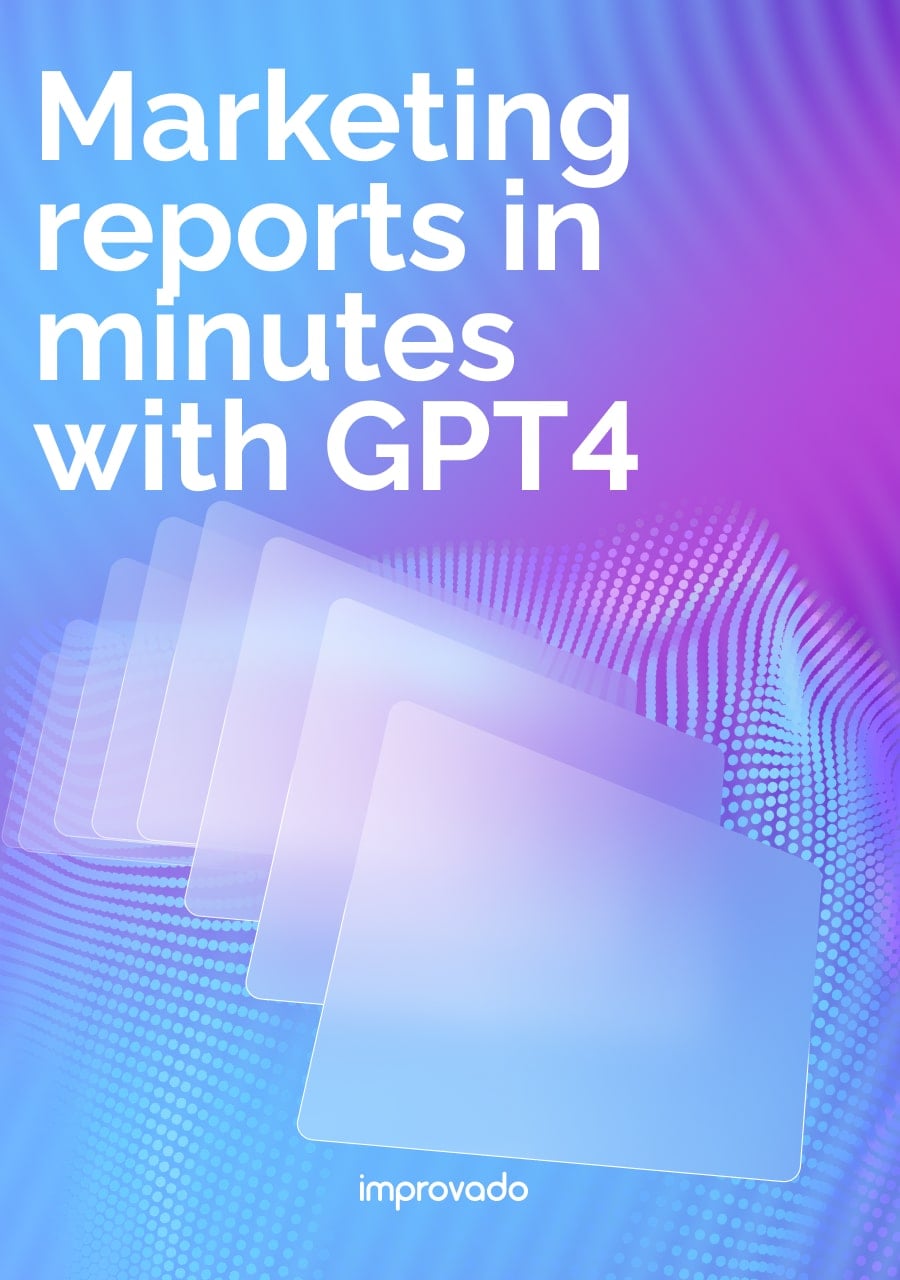Healthcare organizations operate in a data-rich yet fragmented environment, where clinical, operational, and marketing data often sit in isolated systems.
Navigating HIPAA and other regulatory requirements while extracting actionable insights adds further complexity.
This article explores the leading healthcare analytics platforms that address these challenges, from compliance-ready data integration to advanced visualization and AI-driven insights.
You’ll find a comparative overview, detailed breakdowns of each tool’s strengths, and guidance to help identify the solution best suited to your needs.
What Is Healthcare Analytics Software?
In the marketing and commercial context, healthcare analytics tools help teams understand referral patterns, track patient acquisition, assess campaign effectiveness and service-line profitability, and identify growth opportunities.
Why Healthcare Analytics Software Matters?
The U.S. healthcare landscape is defined by intense competition across an increasingly consolidated ecosystem of health systems, payers, life sciences companies, and digital health providers. These organizations compete not only on clinical outcomes and cost efficiency, but also on patient experience, access to care, and innovation in service delivery.
At the same time, the regulatory environment is among the most complex of any industry. HIPAA, HITECH, CMS rules, and evolving state-level mandates introduce high stakes for data governance, billing practices, digital communications, and value-based care reporting. Missteps carry significant financial and reputational risk.
In this environment, healthcare analytics platforms are essential for making informed, data-driven decisions.
These tools help unify siloed datasets across clinical, financial, and engagement systems, enabling leaders to benchmark performance, identify variability, surface opportunities for improvement, and stay aligned with compliance mandates.
What Are the Key Features to Look For in Healthcare Analytics Platforms?
Considering the unique demands of the healthcare industry, analytics tools must do more than generate reports. The features outlined below are essential for selecting a solution that meets the realities of healthcare analytics at scale:
- Data integration and interoperability: Healthcare organizations typically manage fragmented data across EHRs, claims systems, CRM platforms, billing, and marketing tools. A strong analytics solution should offer native connectors or robust APIs to unify these data streams.
- HIPAA and compliance-grade security: Given the sensitivity of healthcare data, the software must be HIPAA-compliant and meet any relevant state-level mandates. Look for role-based access controls, audit logs, data encryption at rest and in transit, and the ability to host on-premise or within a private cloud.
- Data governance and auditability: In regulated industries, data lineage and governance frameworks are key. Healthcare analytics tools should support naming conventions, transformation logic tracking, and version control to ensure trust and traceability across teams.
- Advanced analytics and AI capabilities: Predictive modeling, natural language processing, and machine learning are increasingly vital in identifying care gaps, forecasting utilization, and optimizing targeting strategies. Tools should support these functions in a transparent and auditable manner.
- Multi-source attribution: Healthcare marketing often spans both healthcare professional (HCP) and patient touchpoints. Platforms should enable multi-touch attribution across digital campaigns, field rep interactions, EMR platforms, and medical conference activity.
Top 10 Healthcare Analytics Software in 2025
Selecting the right healthcare analytics platform depends on factors such as organizational goals, compliance requirements, scalability needs, and the types of data being analyzed.
The table below compares leading solutions based on their best-fit scenarios, standout capabilities, and pricing models.
In the following sections, we’ll take a closer look at each platform and its key features.
| Platform | Best for | Notable feature | Pricing |
|---|---|---|---|
| Improvado | Healthcare marketing analytics and campaign monitoring | AI Agent deployed within your DWH for secure querying | Custom |
| Tableau | Enterprise-wide healthcare analytics and visualization | Highly customizable dashboards with HIPAA-compliant deployment options | From $15/user/month |
| Power BI | Analytics for Microsoft-centric organizations | Seamless integration with Microsoft ecosystem and HIPAA-compliant setup | From $10/user/month |
| Health Catalyst | Population health management and outcomes improvement | Data operating system unifying clinical, financial, and operational data | Custom |
| Innovaccer | Value-based care and population health analytics | Unified patient record platform with advanced risk stratification | Custom |
| Sisense | Embedded healthcare analytics and BI | In-chip analytics engine for fast processing of complex datasets | Custom |
| Qlik Sense | Self-service healthcare analytics and reporting | Associative data model enabling discovery across multiple data sources | From $30/user/month |
| Domo | Real-time operational and marketing healthcare dashboards | Cloud-native BI with prebuilt healthcare data connectors | Custom |
| MedeAnalytics | Healthcare financial performance and quality improvement | Preconfigured healthcare modules for payers and providers | Custom |
| Optum | Enterprise-scale healthcare performance management | Integrated claims, clinical, and market analytics ecosystem | Custom |
1. Improvado

Improvado is a HIPAA-compliant marketing intelligence platform used by healthcare and pharmaceutical organizations to centralize and operationalize their marketing performance data.
It provides a secure and customizable environment for analyzing complex campaigns across paid media, CRM, and custom touchpoints without compromising regulatory compliance.
The platform’s AI layer can operate on top of a company’s data warehouse, eliminating the need to replicate sensitive data externally. This enables HIPAA-compliant teams to generate insights, identify anomalies, and automate reporting within a governed framework.
Key capabilities include:
- All-in-one solution: Improvado unifies and automates the entire marketing reporting cycle, including ETL/ELT pipelines, data modeling, attribution, BI dashboards, and AI analytics.
- Robust data security: The platform includes built-in safeguards such as encryption at rest and in transit, role-based access controls,and audit logging.
- Data integration: 500 pre-built data source connectors and support for custom sources and flat data ingestion.
- No-code data transformation: To clean, normalize, and model data with auditability.
- Automated campaign monitoring: Validates data quality, and detects and alerts on errors in campaign tracking, metrics pacing, and spend, reducing time lost to manual QA across channels.
- BI integration: Flexible delivery of transformed data to BI tools, dashboards, or warehouse destinations.
- Naming conventions module: Automatically audits and corrects campaign naming inconsistencies across all major ad platforms and then syncs the clean, standardized names back to those platforms.
Improvado pricing
Improvado offers three custom-tailored pricing tiers—Growth, Advanced, and Enterprise, that differ in the number of data rows, customization credits, and access to advanced features.
All pricing plans include HIPAA and SOC 2 Type II security measures.
All plans include access to 500+ connectors and allow unlimited accounts per data source. AI-enabled capabilities—like the AI Agent and marketing data governance—are available through configurable add-ons across all packages.
2. Tableau
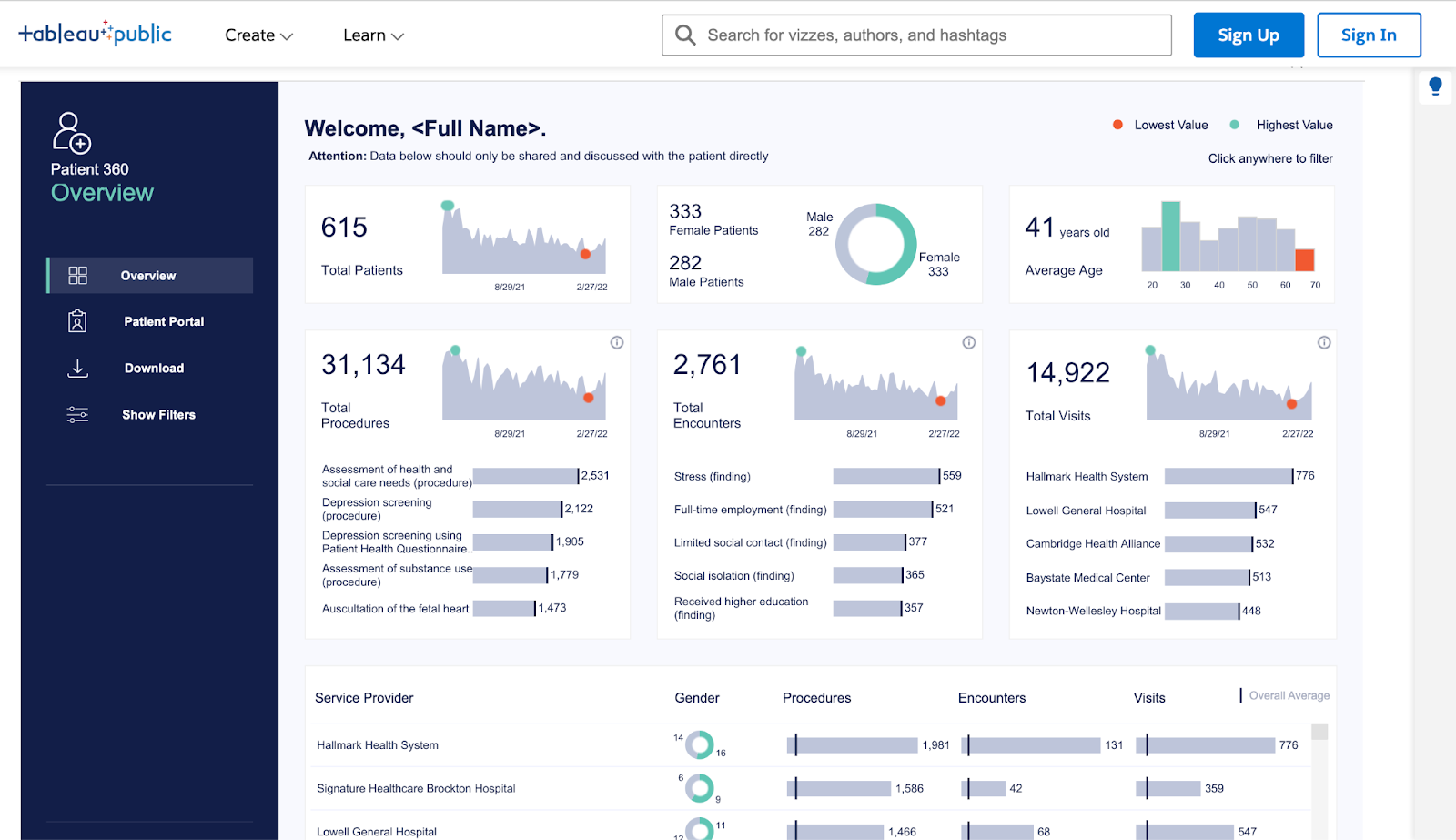
Tableau is a widely adopted analytics and data visualization platform used across healthcare organizations to surface insights from large, fragmented datasets.
Key capabilities include:
- Rich visual storytelling: Provides a drag-and-drop interface and an extensive selection of visualization types to suit various data stories.
- Predictive insights and anomaly detection: Leverage built-in forecasting and pattern identification to anticipate shifts in patient engagement or campaign effectiveness.
- Scalable collaboration: Share content across fields, clinical, operational, and marketing, with granular permissions and row-level security to enforce data governance.
- Flexible deployment options: Choose between on-premise, self-managed environments, or cloud deployment, allowing alignment with institutional IT policies and compliance priorities.
Tableau pricing
Tableau pricing is based on a tiered subscription model with role-based licenses:
- Creator (for analysts and developers who build dashboards): around $70–75 per user per month (billed annually). This license includes Tableau Desktop, Tableau Prep, and full authoring capabilities.
- Explorer (for users who interact with dashboards and do light editing): approximately $42 per user per month (annual billing).
- Viewer (for read-only users consuming reports): about $15 per user per month (billed annually).
Healthcare organizations typically need a mix of these licenses depending on their team roles.
Pricing can scale with additional add-ons for advanced data management or AI features.
3. Power BI
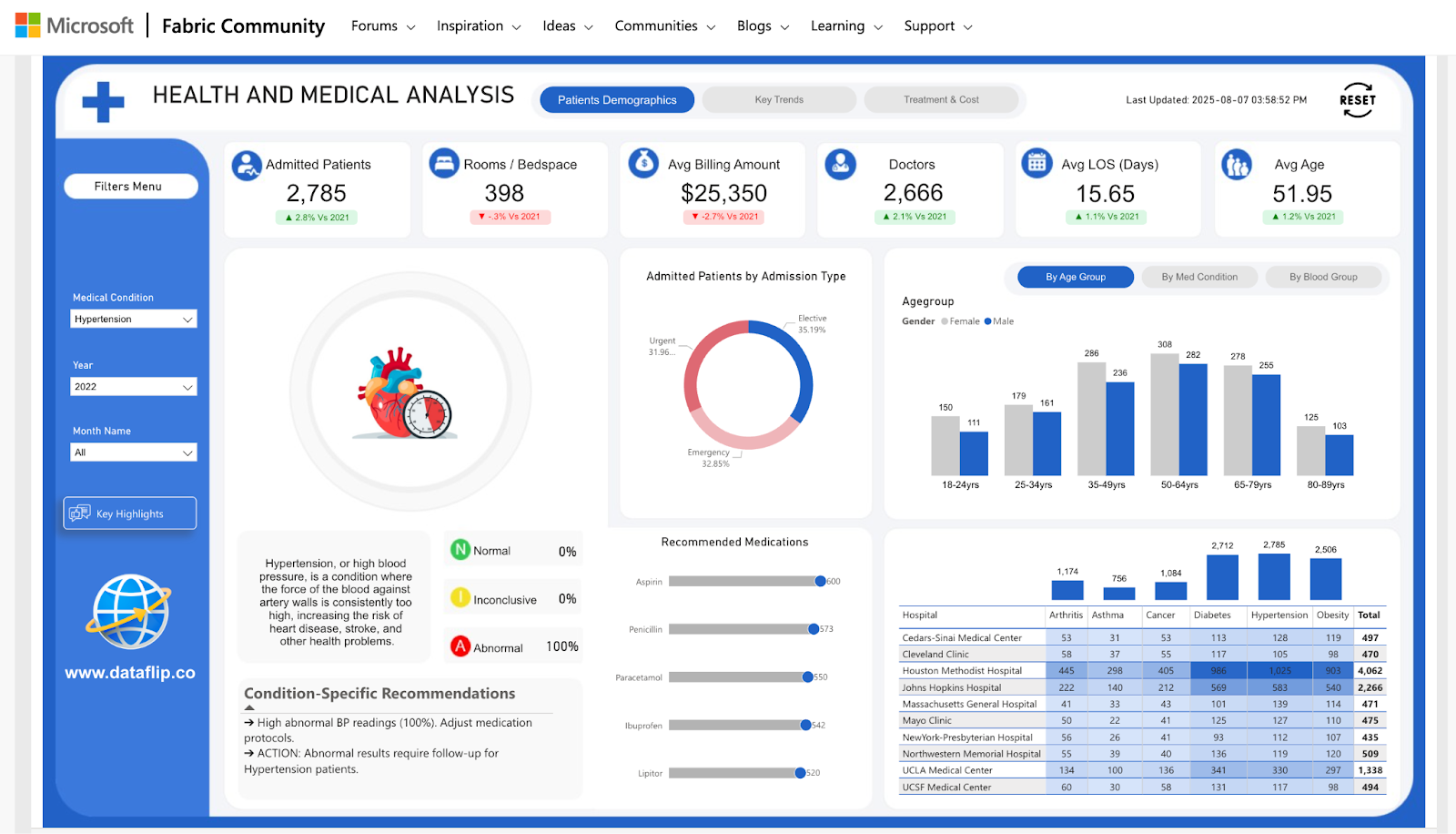
Example of Power BI visualizations; a dashboard is available in Power BI Forums
Power BI is Microsoft’s business intelligence platform that enables healthcare organizations to aggregate, analyze, and visualize marketing and operational data.
Power BI can be configured to meet HIPAA compliance requirements when deployed within a secure Microsoft Azure environment.
Key capabilities include:
- Advanced visualizations: Customize reports to track campaign attribution, engagement trends, or HCP response rates by region or specialty.
- Azure integration: Seamless connectivity with Microsoft Cloud services like Azure Synapse or Dataverse to consolidate marketing, CRM, and clinical data.
- Data modeling tools: Build calculated metrics and relationships across datasets to support deeper analysis of marketing ROI and funnel velocity.
- Row-level security: Restrict access to sensitive data by user role or department, supporting internal data governance policies.
Power BI pricing
Microsoft Power BI pricing follows a tiered subscription model:
- Power BI Pro: $14 per user per month
- Power BI Premium Per User (PPU): $24 per user per month
These licenses cover data visualization, report creation, and advanced analytics tools, which are suitable for healthcare analytics needs, including healthcare marketing analytics.
4. Health Catalyst
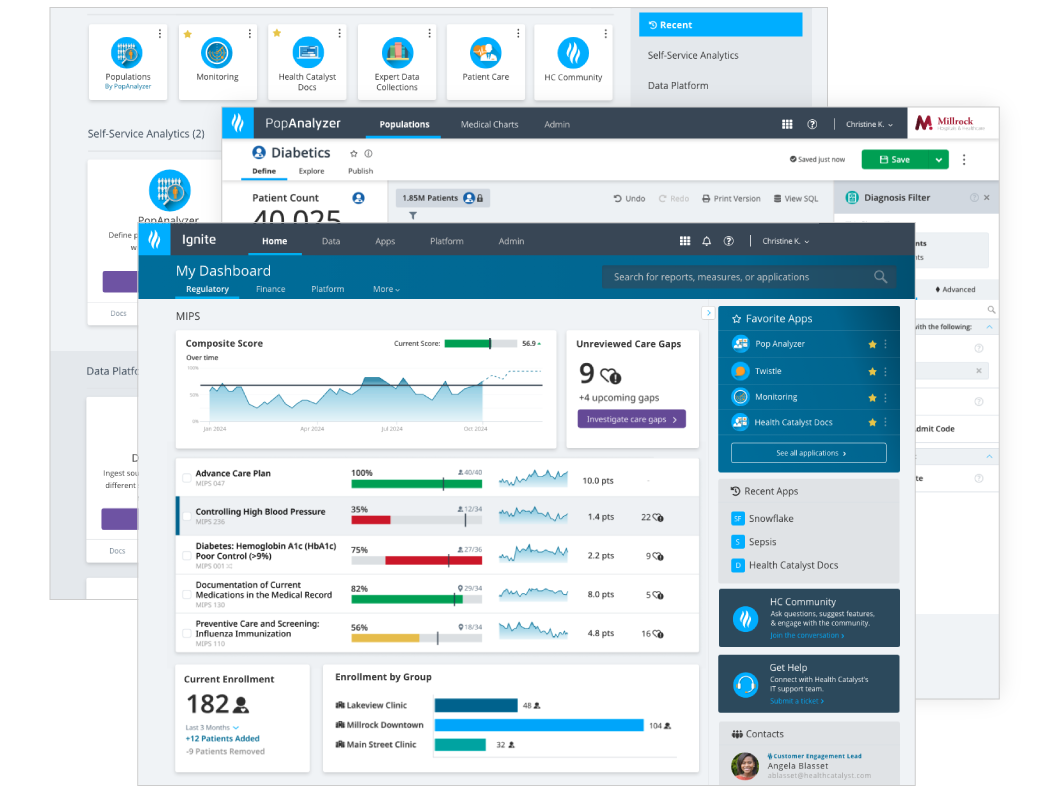
Health Catalyst is a healthcare-specific analytics and data platform that combines a cloud-based data warehouse with advanced analytics, data visualization, and reporting capabilities tailored to the unique needs of the healthcare industry.
The platform is designed with HIPAA compliance at its core, offering end-to-end data security through encryption, role-based access controls, and secure hosting options.
Key capabilities include:
- Enterprise data warehouse: Integrates data from EHRs, claims systems, patient engagement platforms, financial systems, and other healthcare sources into a single, governed repository.
- Analytics applications: Offers a suite of pre-built and customizable analytics apps for population health management, clinical performance tracking, operational efficiency, and financial optimization.
- Predictive and prescriptive analytics: Uses AI and machine learning to forecast patient risk, identify cost drivers, and suggest targeted interventions.
- Quality and compliance reporting: Supports performance reporting for value-based care initiatives, regulatory submissions, and internal quality improvement programs.
- Self-service data access: Enables clinicians, administrators, and analysts to explore data and build reports without heavy reliance on IT teams.
Health Catalyst pricing
Health Catalyst's pricing is not publicly available. You need to request a demo to get any information on the plans.
5. Innovaccer
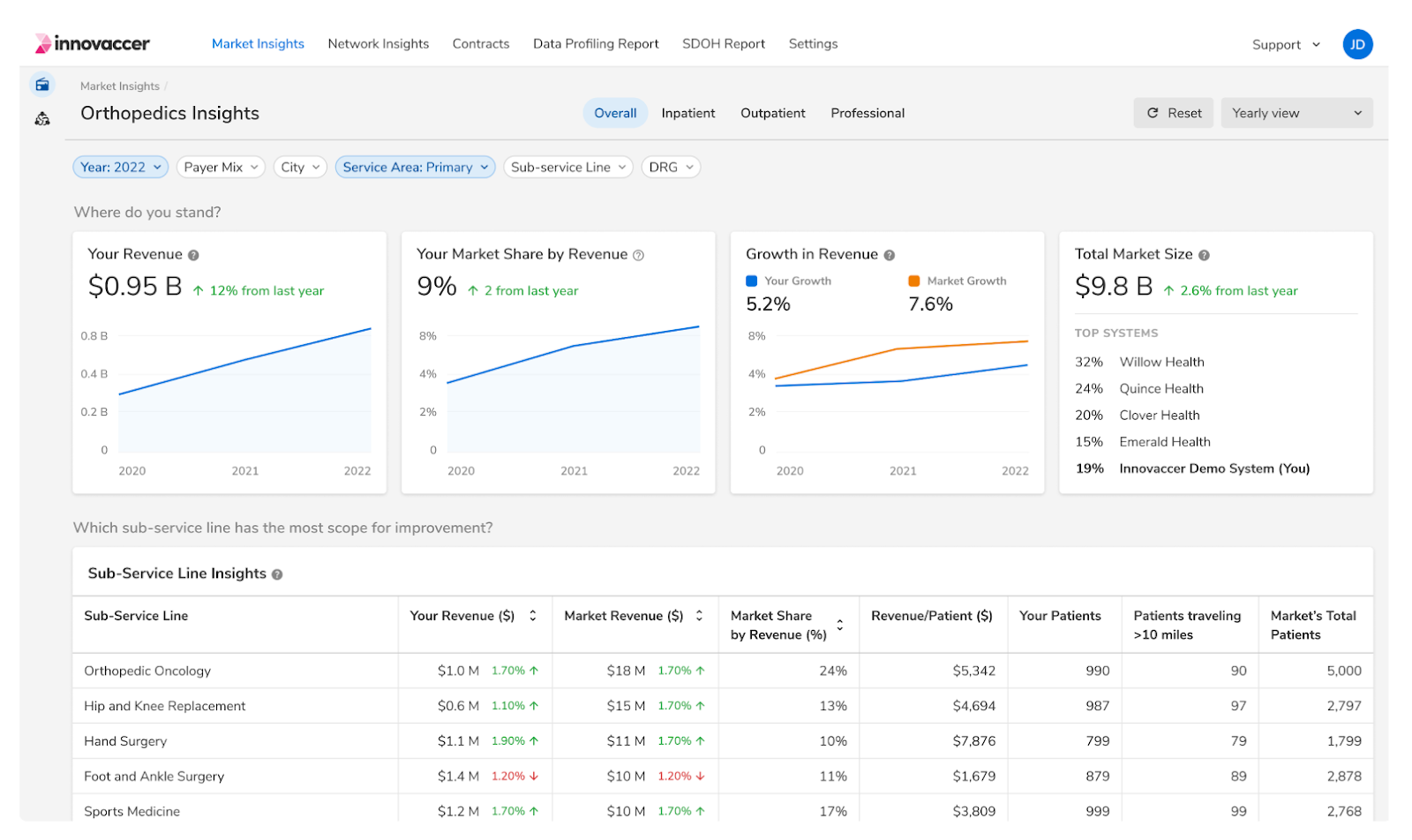
Innovaccer is a healthcare data platform designed to unify patient data from multiple sources and enable data-driven care delivery. The unified view supports improved care coordination, population health management, and performance measurement across healthcare networks.
Key capabilities include:
- Data integration and interoperability: Connects with EHRs, HIEs, payer systems, labs, and other healthcare data sources through industry-standard protocols like HL7, FHIR, and APIs.
- Population health management: Offers analytics tools to stratify risk, monitor care gaps, and design targeted interventions to improve outcomes and reduce costs.
- Value-based care enablement: Provides performance tracking and reporting capabilities aligned with value-based care contracts, quality programs, and reimbursement models.
- Care coordination tools: Facilitates communication and task management between care teams, enabling better patient engagement and follow-up.
- Advanced analytics and AI models: Applies predictive models for readmission risk, chronic disease progression, and utilization forecasting to inform proactive care strategies.
Innovaccer pricing
Innovaccer doesn’t disclose any pricing information on its website.
6. Sisense
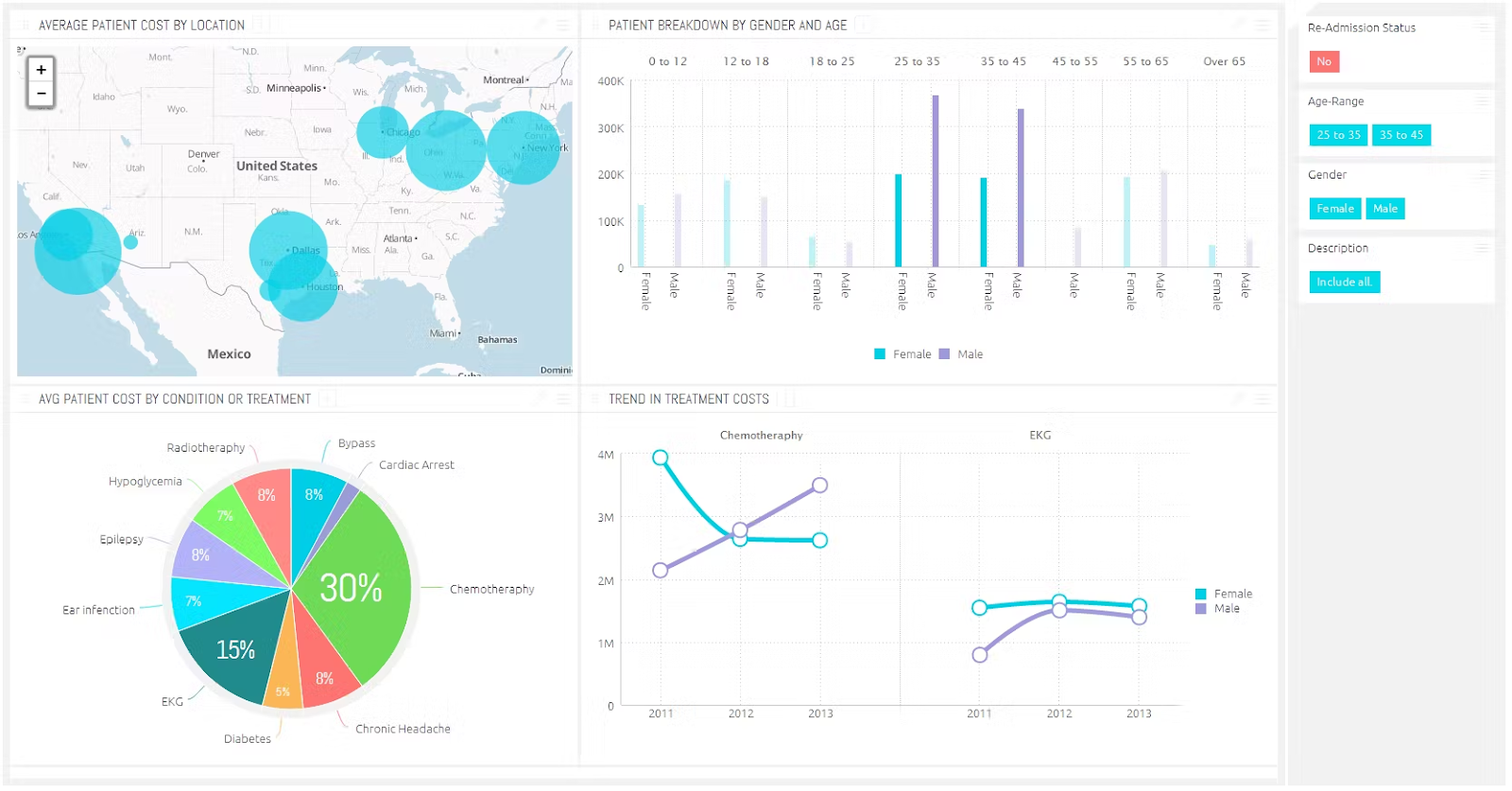
Sisense is a business intelligence and analytics platform that can be adapted for healthcare and healthcare marketing analytics.
The platform offers HIPAA-compliant deployment options, including secure cloud and on-premises environments, with encryption in transit and at rest, role-based permissions, and audit logging to protect sensitive health and marketing data.
Key capabilities include:
- Data integration across sources: Combines data from EHRs, CRM systems, claims databases, call centers, marketing automation tools, and digital ad platforms for a unified view.
- Custom dashboards and visualizations: Allows creation of role-specific dashboards for executives, clinicians, and marketing teams to monitor KPIs in real time.
- Embedded analytics: Integrates analytics directly into operational and patient engagement applications, enabling data-driven decision-making in daily workflows.
- Predictive modeling and AI: Uses machine learning to forecast patient acquisition trends, campaign conversion rates, and resource utilization.
- Self-service analytics: Empowers non-technical users to explore data, drill down into campaign or patient engagement metrics, and uncover new opportunities without heavy IT reliance.
Sisense pricing
Sisense pricing is not publicly available. To learn the details, companies need to request a call.
7. Qlik Sense
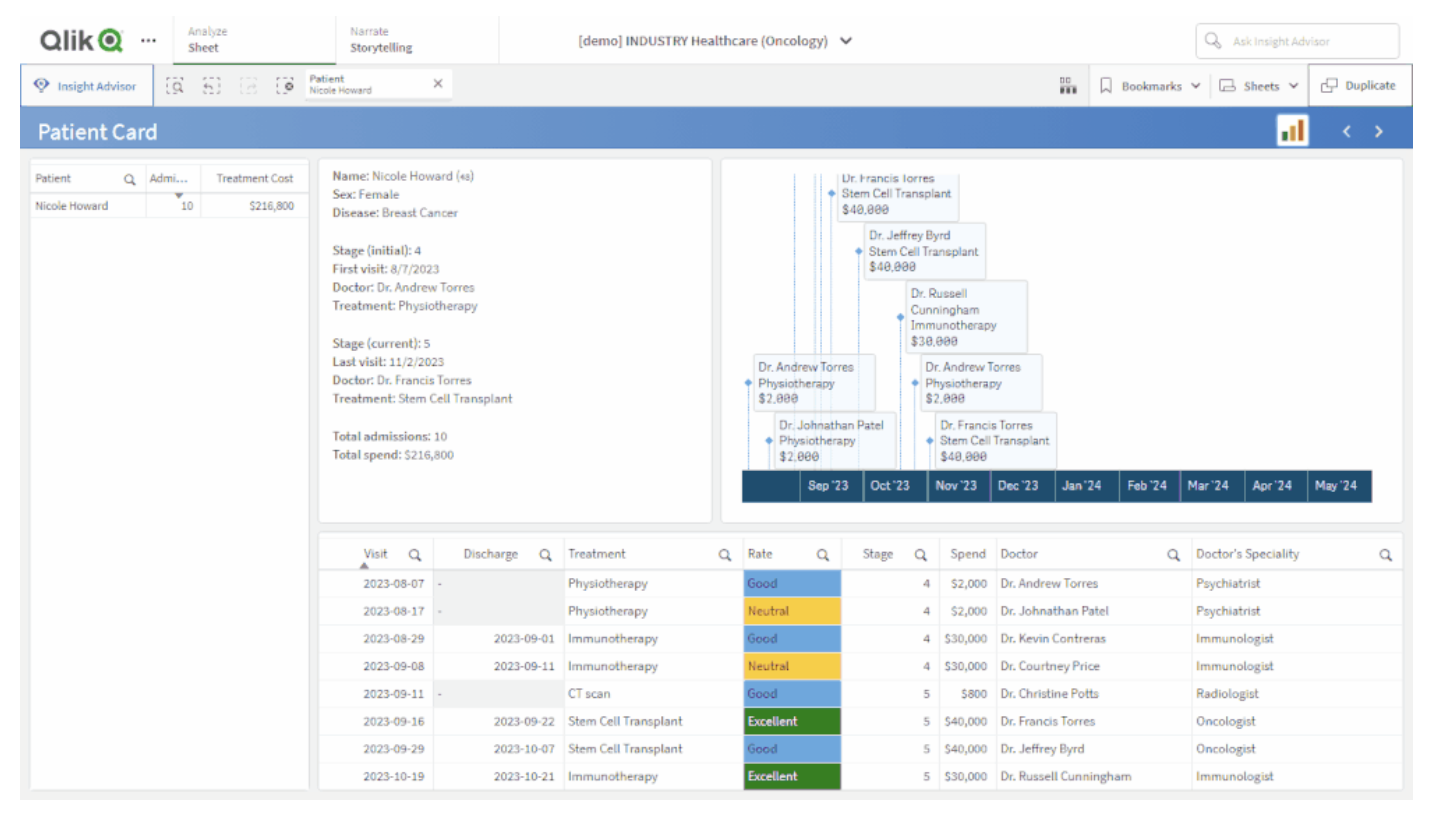
Qlik Sense is a data analytics and visualization platform that supports healthcare and healthcare marketing analytics, providing a HIPAA-compliant environment.
The platform offers deployment options that meet healthcare security requirements, including encryption in transit and at rest, fine-grained access controls, and audit capabilities to ensure patient and marketing data privacy.
Key capabilities include:
- Associative data exploration: Connects insights from EHRs, CRM systems, claims, patient engagement platforms, and marketing channels without predefined query paths.
- Custom dashboards and reporting: Creates interactive, role-based dashboards that track marketing KPIs, patient acquisition metrics, referral patterns, and campaign ROI.
- Advanced analytics integration: Connects with AI and machine learning models to support predictive analysis, such as patient churn forecasting or campaign performance optimization.
- Data storytelling: Allows teams to combine analytics with narrative elements to share insights in a clear, contextual format across clinical and marketing teams.
- Self-service and collaboration: Empowers both analysts and non-technical users to perform ad hoc analysis, share findings, and make real-time decisions without relying heavily on IT.
Qlik Sense pricing
Qlik pricing is structured in tiered subscription plans based on capacity and user counts.
For instance, Starter Plan costs $200 per month for 10 users with 25 GB of data for analysis. It includes AI analytics, interactive visualizations, basic connectors, and community support. The plan is suitable for small businesses.
8. Domo
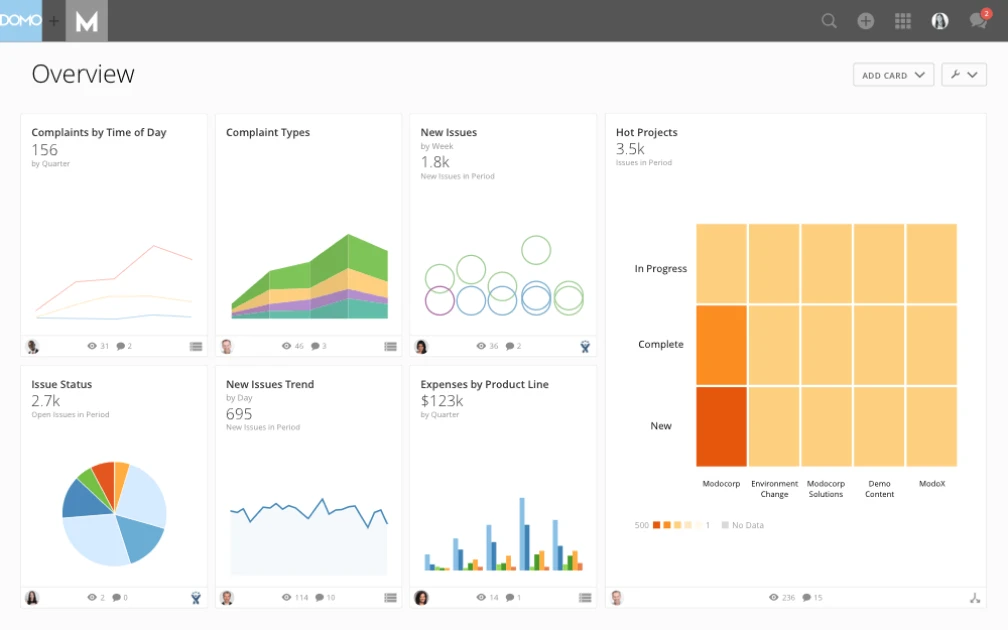
Domo is a cloud-based business intelligence and analytics platform. Its architecture supports HIPAA compliance, offering encryption, secure data sharing, and access controls to protect sensitive patient and campaign information.
Designed for rapid deployment, Domo connects directly to EHRs, CRMs, claims databases, patient engagement tools, and digital marketing platforms, helping healthcare marketers and analysts create a single view of operations.
Key capabilities include:
- Unified data integration: Connects hundreds of healthcare, marketing, and enterprise data sources into one secure platform.
- Real-time dashboards: Tracks KPIs like patient acquisition cost, referral trends, campaign engagement, and treatment adherence in a live environment.
- Predictive and prescriptive analytics: Applies AI-driven insights to forecast patient demand, predict campaign outcomes, and identify high-value audience segments.
- Collaboration and alerts: Enables cross-team sharing of dashboards and automated alerts when performance deviates from benchmarks.
Domo pricing
Domo's pricing is not publicly listed; talk to sales to learn more details. The platform includes a 30-day free trial.
9. MedeAnalytics
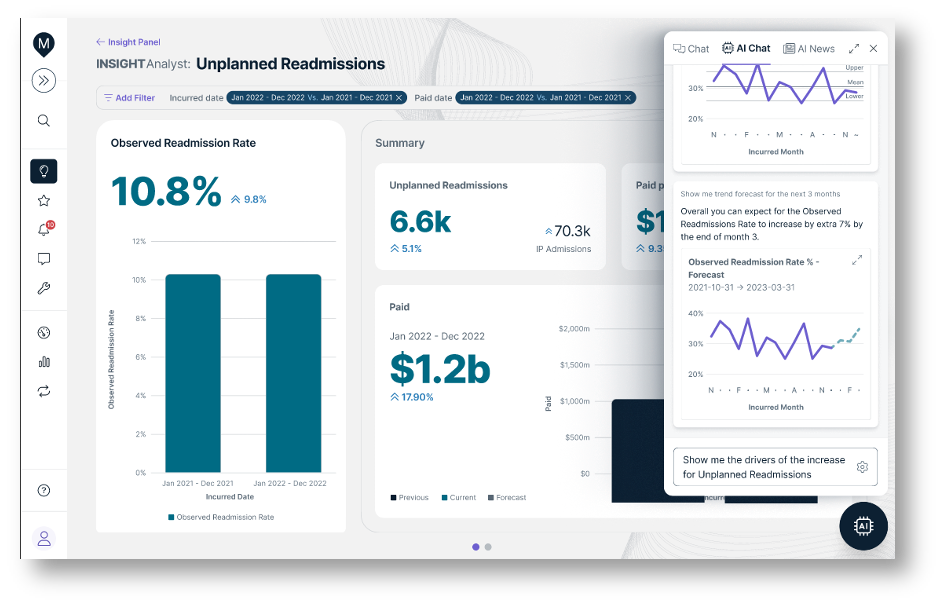
MedeAnalytics is a purpose-built healthcare data analytics platform that delivers data-driven insights across clinical, operational, and financial domains.
The platform specializes in aggregating data from EHRs, claims systems, patient engagement tools, and financial records, enabling healthcare organizations to analyze performance across the care continuum.
Its modular approach allows teams to address specific needs, such as population health management, revenue cycle optimization, or marketing effectiveness, while still benefiting from a unified analytics foundation.
Key capabilities include:
- Integrated data views: Consolidates clinical, financial, and operational datasets for a holistic performance picture.
- Patient and population analytics: Identifies trends in patient behavior, outcomes, and demographics to support targeted interventions.
- Revenue and financial insights: Analyzes claims, billing, and reimbursement data to improve revenue cycle efficiency.
- Operational and workforce analytics: Tracks resource utilization, staffing metrics, and efficiency benchmarks.
- Custom reporting and dashboards: Offers configurable visualizations tailored to both leadership and departmental needs.
MedeAnalytics pricing
MedeAnalytics pricing is not publicly available.
10. Optum by UnitedHealth Group
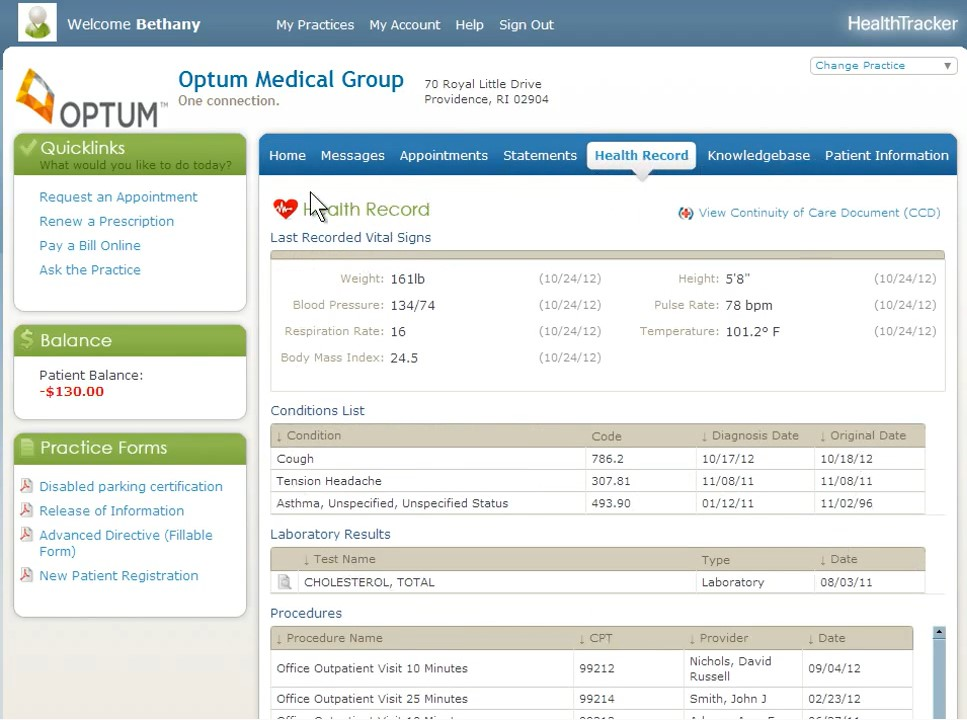
Optum, a subsidiary of UnitedHealth Group, offers a comprehensive healthcare analytics and services platform designed to improve clinical, operational, and financial performance.
The platform combines claims, clinical, patient engagement, and operational data into a unified ecosystem. Its analytics capabilities extend from population health management and care quality monitoring to cost containment and market intelligence, supporting both provider and payer organizations.
Key capabilities include:
- Population health analytics: Identifies at-risk populations, tracks outcomes, and supports value-based care initiatives.
- Claims and utilization insights: Analyzes service utilization patterns, cost drivers, and reimbursement trends.
- Clinical performance monitoring: Measures quality of care, guideline adherence, and patient outcomes.
- Market and network analytics: Assesses provider networks, referral patterns, and competitive positioning.
- Predictive modeling and risk scoring: Uses AI and machine learning to anticipate patient needs, readmission risks, and cost impacts.
Optum pricing
Optum pricing depends on the specific service division: OptumHealth (health management and care delivery), OptumRx (pharmacy benefit management), and OptumInsight (data analytics and consulting), and varies by client type, service volume, customization, and technology needs.
What are the Latest Trends in Healthcare Analytics?
Despite being highly regulated and, in some cases, conservative in adopting change, the healthcare analytics space continues to evolve rapidly. Advances in technology, shifts in care delivery models, and market pressures are driving innovations.
Here are some of the trends that will shape the industry in the coming years:
- AI augmentation and human–AI collaboration: AI is increasingly used to provide predictive analytics, automate diagnostics, optimize hospital resource utilization, and facilitate multidisciplinary collaboration, with final decisions still made by humans to strike a balance between speed and accuracy.
- Internet of Medical Things (IoMT) and wearables: The growth of connected medical devices and wearable health trackers is generating continuous streams of patient data. Integrating this data into analytics platforms enables proactive monitoring, personalized interventions, and early detection of health issues.
- Emphasis on data interoperability and patient-centric care: Seamless data exchange between EHRs, claims systems, and patient engagement platforms is becoming essential. Improved interoperability supports more comprehensive patient views, enabling analytics to focus on outcomes and personalized care strategies.
- Real-world evidence (RWE) for outcome-based models: Payers and providers are increasingly using RWE to evaluate treatment effectiveness, negotiate value-based contracts, and demonstrate clinical impact in real-world settings.
- Privacy-first AI environments: As AI adoption accelerates, healthcare organizations are prioritizing private, compliant AI deployments that run within their own infrastructure, ensuring sensitive data never leaves their controlled environment.
Finding the Best Fit for Your Healthcare Analytics Needs
Selecting the right healthcare analytics platform is rarely a straightforward process.
The complexity of healthcare data, strict compliance requirements, diverse stakeholder needs, and pressure to demonstrate ROI mean that no single “all-in-one” tool will fully address every challenge.
While many platforms promise broad capabilities, organizations often need to integrate multiple solutions to cover clinical, operational, and marketing analytics in a way that aligns with both strategic goals and regulatory obligations.
For healthcare organizations seeking to enhance their marketing analytics, Improvado provides a HIPAA-compliant platform that unifies, transforms, and analyzes marketing performance data across various channels.
By providing access to all data connectors, enabling secure AI analysis within your own infrastructure, and supporting advanced customization, Improvado helps marketing teams measure campaign impact, optimize budgets, and operate confidently in a regulated environment.
.png)



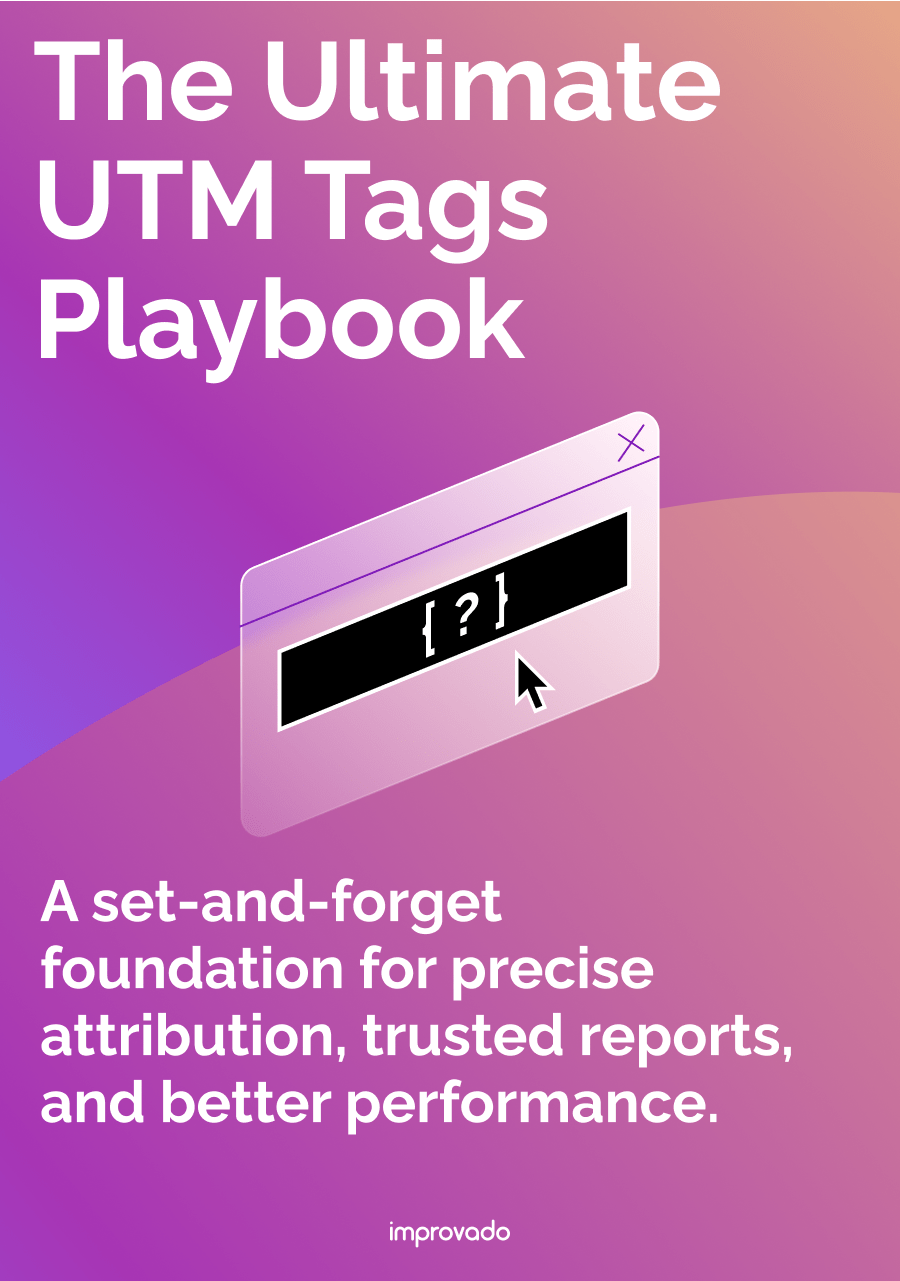
.png)
